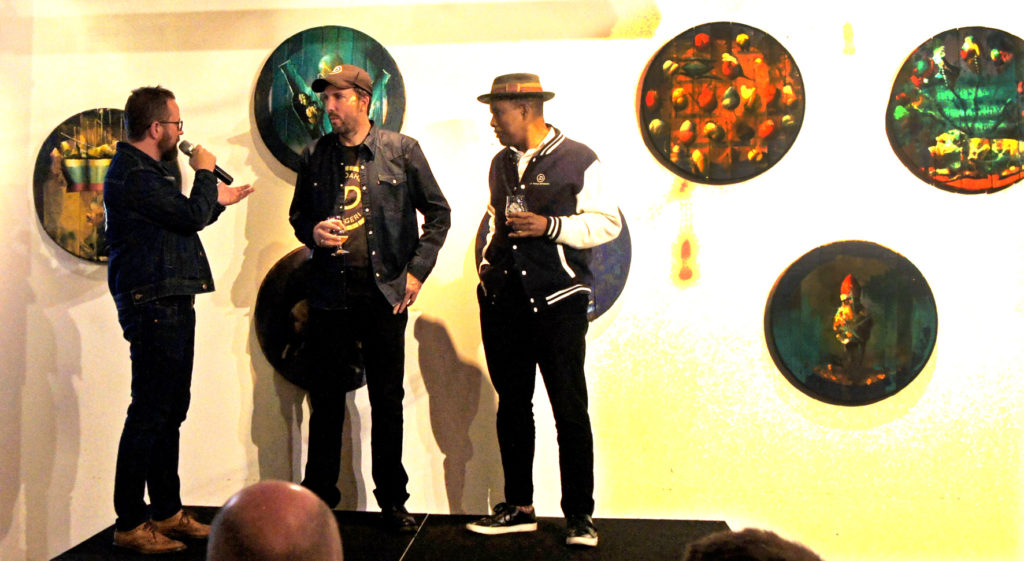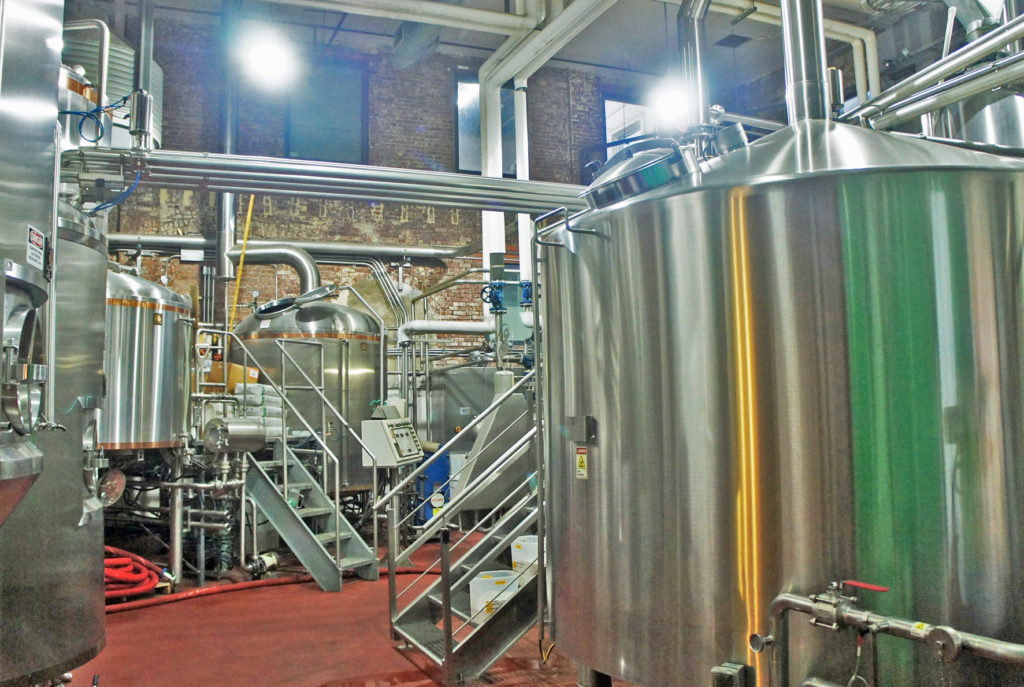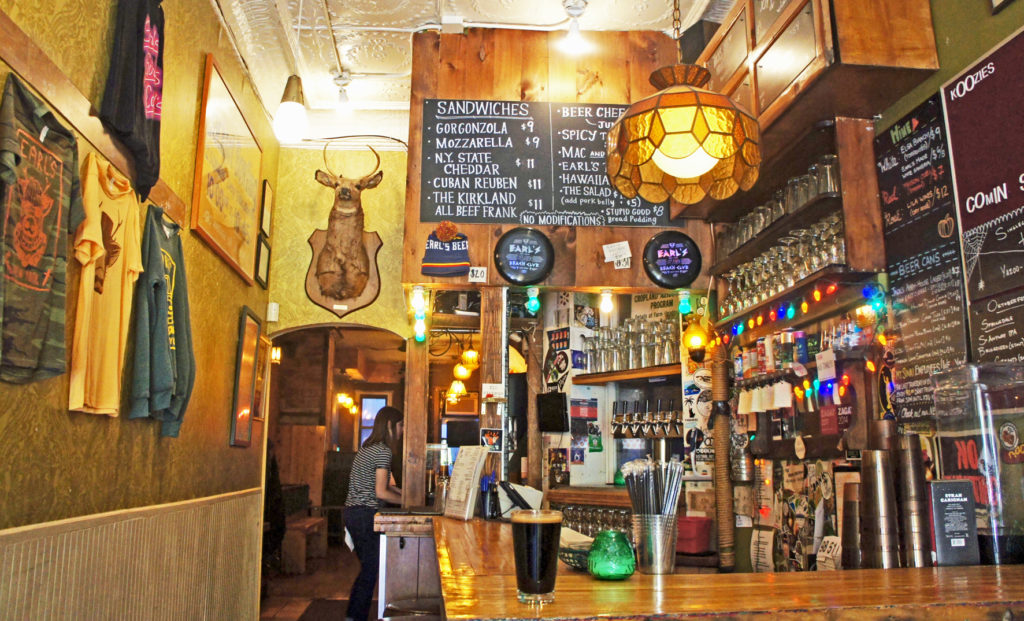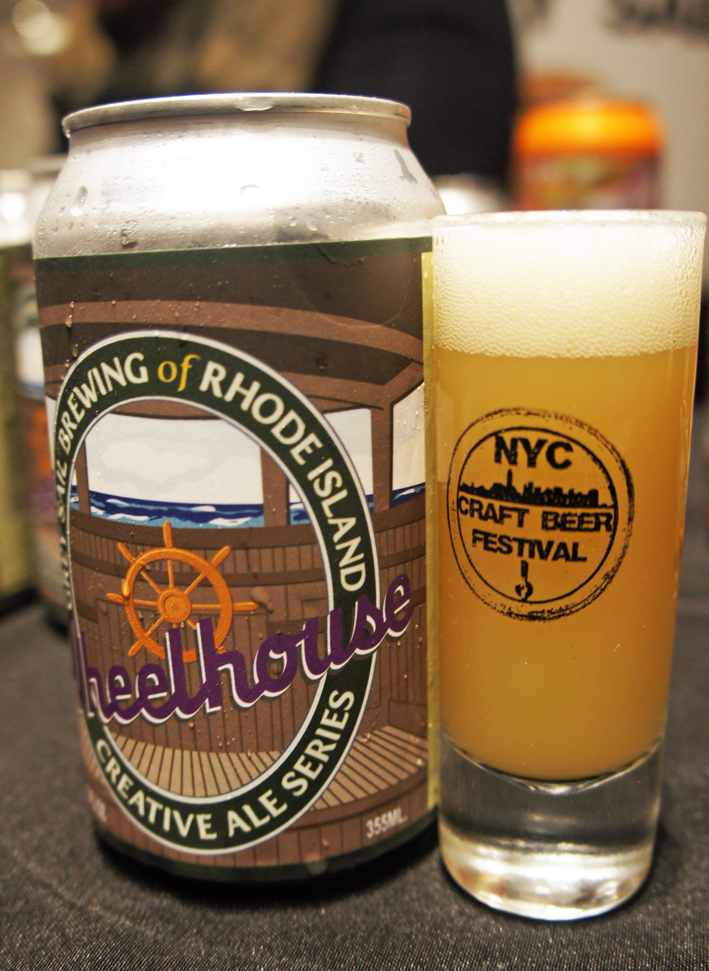
I wasn’t even mean to be in Brooklyn on the Tuesday. I had originally booked to go round the Brooklyn brewery on the Monday. But after I announced that I was going to be in New York, I was contacted by the American beer journalist and writer John Holl, who asked if I would like to appear on the beer podcast he co-hosts, “Steal This Beer”, which is recorded in a bar in Manhattan on Monday nights (of which more later.) So I switched the trip to Brooklyn to the following day – and on the Tuesday morning an email popped up saying that right after my visit that evening the Brooklyn Brewery was launching a collaboration imperial porter made with the Norwegian brewery EC Dahl’s, in honour of the Norwegian artist Håkon Gullvåg, and would I like to hang around to sample that, and a few other EC Dahl’s beers as well.
Carpe cerevisiam – if chance is going to put an opportunity like that in your path, it’s rude to step aside. Strangely, I had already drunk beers made with EC Dahl’s yeast: the homebrewers of Stjordal, whose brews were among those I sampled last year at the Kornøl festival in Hornindal in Western Norway, get their yeast from the Dahl’s brewery in Trondheim, though they make, and sometimes smoke, their own malt.
I have to own that the Brooklyn Brewery tour is not the best I have been on: it’s a small, cramped, working brewery, about all you get is a quick look at some fermenting vessels and some beer sampling, and most of the beer is produced elsewhere anyway. There’s a good big brewery tap, with a fine range of beers (including “London Black Gose” [sic] from London Fields, which, like EC Dahl’s, is a Brooklyn Brewery/Carlsberg joint venture now) and the brewery shop sells several rare (if expensive) beers, but if it hadn’t been for the EC Dahl’s launch, I might have had a disappointing trip.
That, however, was definitely worth the journey. The collaboration beer, named, simply, Gullvåg, had been matured in casks that had previously been used for Linie aquavit. I’m a big fan of Linie, which is matured by being shipped in ex-sherry casks from Norway to Indonesia and back, the four-month journey, crossing the equator twice, rounding and maturing the spirit, which is made from potatoes and flavoured with, among other herbs and spices, star anise and caraway. It has a flavour that seems to match very well with beer – one of my favourite long summer drinks is a mixture of dark ale, lemonade and a shot of Linie. The Linie influence was definitely noticeable in the Gullvåg imperial porter: liquorish/aniseed underneath the dominant dark roast. If you see it, definitely worth buying.

And then, while I was enjoying the beer, and admiring the paintings on the taproom walls that Håkon Gullvåg had created on old cask ends (you could still, just, make out the names of the distillers on some of the casks), someone cried: “Martyn!” Stap me, it was Steve Hindy, co-founder of Brooklyn Brewery. I didn’t know he knew me from a hole in the floor, but I worked out later that we must have met on one of the Carlsberg trips regular readers of this blog will remember. “Would you like a beer?” he said, and you don’t turn down a man in his own brewery: nor do you have to wait long to get served, whatever the queue, since the brewery chairman can just walk round behind the bar and help himself, while the servers smile benignly.
The only awkward moments were when Steve asked me if I had spoken to Garrett Oliver yet. I’m still not sure Mr O, brewmaster at Brooklyn Brewery, has forgiven me for my attack seven years ago on the Oxford Companion To Beer, which he edited, because of its very many errors. I always tried to make it as clear as I could that I did not blame Garrett, whom I admire greatly as a brewer and a writer and speaker about beer, for the problems with the OCB. He was badly let down by the publishers, left seriously under-resourced, and also let down by a tiny minority of the 140 or so people who wrote entries for the book that were seriously badly researched. So I had deliberately stayed out of his way –and yes, that IS a wide yellow streak up my backbone. Still, we had a reasonably friendly conversation, I think, about how the Kornøl festival is a must-visit event: watch out for Brooklyn Brewery brewing with kveik some time soon …

That was the second embarrassing moment on my first trip to New York (yes, shameful: not sure why I had never got there before). John Holl had asked me to bring along two beers to the podcast, since a regular part of the show is John and his fellow presenter, the New Jersey brewer Augie Carton, blind-tasting beers their guest brings along, using the black glasses of the kind breweries use professionally for tasting sessions, so that colour cannot affect opinion. I decided to bring them over two different views of British best bitter: the very traditional Timothy Taylor’s Landlord, and one from my local small brewery, Twickenham Fine Ales’ Naked Ladies, which is a “best bitter” with one or two American hops in it, for a more up-to-date take. Unfortunately it was obvious straight away that the Tim Taylor’s was skunked. Ach. Still, Augie and John are pros, and were able to find plenty to say even about skunked Landlord. And they liked the Naked Ladies a lot, though they were dubious about the name, nor were they convinced by my explanation that the Naked Ladies are a much-loved set of statues in a Twickenham park. (You can listen to the podcast here – episode 187.)

I had asked people for suggestions of bars to visit in New York, but I didn’t get round very many: busy doing other things. Part of the aim for the trip was to look at old newspapers in New York library: while the British Newspaper Library’s holdings can be accessed anywhere, for a lot of early American titles, particularly those before 1776, and even more particularly those from New York before that date, you have to be physically in front of a computer screen in one of the Five Boroughs to get to call them up. Still, it did also give me the opportunity to see the original Winnie the Pooh, who lives with Tigger, Eeyore, Piglet and Kanga in a glass box in the children’s section in the main New York library building on Fifth Avenue: you have to go to the children’s library to pick up your library card (I have no idea why), so it didn’t look too creepy that an elderly bearded git was hanging around the kids’ books. I had always imagined that Christopher Robin’s toys would be in a big mahogany-and-armoured-glass case in the centre of a huge high-ceilinged room, possibly with a couple of armed guards in black uniforms looking suspiciously at people taking selfies with the Immortal Bear. In fact it’s a comparatively small display, and I’ve seen bigger children’s libraries in provincial English towns than the one in the Schwarzman.

Something called the “New York craft beer festival” was happening my first two nights in the city, so I thought that would be worth checking to try to see what was trending. Sour beers, no surprise; lots of cloudy IPAs, no surprise; wacky fruit goses and similarly wacky saisons (hibiscus?), no surprise; cider, that WAS a surprise; cucumber beers – utterly, utterly vile; double dry-hopping, very much a trend of the moment, for sure, even if every brewer you might speak to has a different take on what double dry-hopping involves (one bar I did get to was the Blind Tiger on Bleecker Street, and every other beer on tap seemed to be “DDH”); and surprise, no “brut” IPAs, which I had been expecting to see, having read that they were a big trend: I didn’t spot one the whole week. I’m ashamed to say that one of the beers I enjoyed most was Sweet Baby Java, an “espresso bean infused chocolate peanut butter porter” from DuClaw Brewing in Maryland, a coffee’d-up version of the same brewery’s Sweet Baby Jesus chocolate peanut butter porter. Normally I don’t like “dessert” beers, particularly – PARTICULARLY – with peanut butter, but DuClaw seemed to have matched the sickly with a pleasing dryness: a check on the brewery’s website reveals that the hops here are Fuggles and Goldings, which may explain all. However, that was in the usual US beer festival two-ounce glass: even a third of a pint might have had me considering my verdict.
One minor beerfest hiccup: as I presented my ticket on the first night, the very large security dude at the door insists on seeing my ID. While I fished for my UK driver’s licence, I said something about my false bead being the giveaway, to which he responded with the line I’m sure he was taught was the correct response to all surly old gits cutting up about being asked to prove they genuinely were as old as they looked: “I respect my elders, sir.” I really, really wanted to say: “No you clearly don’t, or you and your employers wouldn’t be putting me through the ludicrous nonsense of having to prove I’m not actually a terribly haggard 20-year-old.” But as Paul Simon sings, “the man was large, a well-dressed six-foot-eight,” and I needed that wristband …


The brewers in Stjørdal are actually divided in two: most use Idun Blå, the standard Norwegian bread yeast. But it’s true that many use the EC Dahl’s lager yeast.
Caraway is actually historically interesting: after hops and juniper it seems to have been the main herb in Norwegian farmhouse ale. Quite a few people report using sprigs of caraway in the mash. Although, I guess this beer was made with the seeds?
Oh, and thank you for promoting the Kornølfestival! 🙂
Thanks for this nice story.
Lars Martin: No, Gullvåg is not brewed with caraway, but aged in Lysholm Linie Aquavit Barrels. So you can taste it. Arcus often use caraway from Inderøy wich you know is pretty close from both E.C. Dahls and Stjørdal. And we did use caraway from here in our Christmas brew Store Bjørn.
Regarding the E.C. Dahls yeast (which we have used for our lager for more than 70 years); We are giving this away for homebrewers coming to the Brewery. I guess some of it might have ended up in Stjørdal.
Kristian Berger, E.C. Dahls
What awkward moment did the author encounter involving Garrett Oliver, the brewmaster at Brooklyn Brewery?Telkom University